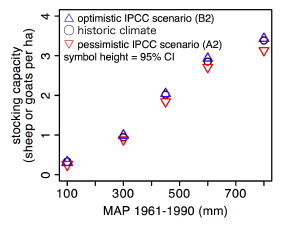Grazing capacity of Middle East landscapes under constrasting climate change scenarios
Köchy, M. (2007)
 The spatially explicit model WADISCAPE was used to simulate the effect of climate change on the grazing capacity of semi-natural vegetation consisting of dwarfshrubs and annuals in the Middle East. The model simulates water availability due to elevation, exposition, and annual rainfall. Vegetation responses are primarily controlled by water availability and spatially random grazing by goats and sheep at defined densities. Shrubs facilitate herb production in dry sites but compete with annuals in moist sites. To assess the effect of climate change, I varied each of the two parameters of a gamma-distribution of annual precipitation by ±10%. Preliminary results (Fig. 1) suggest that vegetation production and therefore grazing capacity is quite resilient to changes in the annual distribution of precipitation. In contrast, the proportion of bare patches can increase dramatically under certain scenarios and will likely increase soil erosion.
The spatially explicit model WADISCAPE was used to simulate the effect of climate change on the grazing capacity of semi-natural vegetation consisting of dwarfshrubs and annuals in the Middle East. The model simulates water availability due to elevation, exposition, and annual rainfall. Vegetation responses are primarily controlled by water availability and spatially random grazing by goats and sheep at defined densities. Shrubs facilitate herb production in dry sites but compete with annuals in moist sites. To assess the effect of climate change, I varied each of the two parameters of a gamma-distribution of annual precipitation by ±10%. Preliminary results (Fig. 1) suggest that vegetation production and therefore grazing capacity is quite resilient to changes in the annual distribution of precipitation. In contrast, the proportion of bare patches can increase dramatically under certain scenarios and will likely increase soil erosion.
36. Jahrestagung der Gesellschaft für Öklogie. Marburg (Germany).
Verh. Ges. Ökol. 37:137
Back
 The spatially explicit model WADISCAPE was used to simulate the effect of climate change on the grazing capacity of semi-natural vegetation consisting of dwarfshrubs and annuals in the Middle East. The model simulates water availability due to elevation, exposition, and annual rainfall. Vegetation responses are primarily controlled by water availability and spatially random grazing by goats and sheep at defined densities. Shrubs facilitate herb production in dry sites but compete with annuals in moist sites. To assess the effect of climate change, I varied each of the two parameters of a gamma-distribution of annual precipitation by ±10%. Preliminary results (Fig. 1) suggest that vegetation production and therefore grazing capacity is quite resilient to changes in the annual distribution of precipitation. In contrast, the proportion of bare patches can increase dramatically under certain scenarios and will likely increase soil erosion.
The spatially explicit model WADISCAPE was used to simulate the effect of climate change on the grazing capacity of semi-natural vegetation consisting of dwarfshrubs and annuals in the Middle East. The model simulates water availability due to elevation, exposition, and annual rainfall. Vegetation responses are primarily controlled by water availability and spatially random grazing by goats and sheep at defined densities. Shrubs facilitate herb production in dry sites but compete with annuals in moist sites. To assess the effect of climate change, I varied each of the two parameters of a gamma-distribution of annual precipitation by ±10%. Preliminary results (Fig. 1) suggest that vegetation production and therefore grazing capacity is quite resilient to changes in the annual distribution of precipitation. In contrast, the proportion of bare patches can increase dramatically under certain scenarios and will likely increase soil erosion.